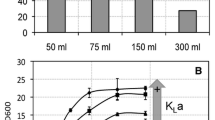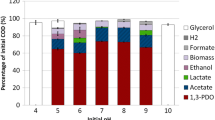Abstract
In shake-flask culture, Methylobacterium extorquens accumulated poly(3-hydroxybutyrate) (PHB) possessing a substantially higher weight-average molecular mass (MW) than previously reported for this organism. The MW of PHB produced by M. extorquens was dependent on the initial concentration of methanol or sodium succinate, used as sole carbon sources. The highest MW values (0.6 and 1.7 × 106) were obtained with low initial concentrations of methanol or sodium succinate (4.0 and 3.0 g l−1, respectively) and the latter substrate always yielded PHB of higher MW than that produced from methanol. Thus PHB with an MW in the range 0.2–1.7 × 106 could be produced by selection of the carbon source and its concentration. In contrast to the findings with M. extorquens, the MW of PHB produced by Alcaligenes eutrophus was high (1.1–1.6 × 106) and generally unaffected by the choice or concentration of the carbon source. The use of glycerol as sole carbon source did, however, result in the accumulation of PHB with a markedly lower MW (5.5–8.5 × 105) than that produced from other sole carbon sources by this organism under similar conditions.
Similar content being viewed by others

References
Anderson AJ, Haywood GW, Williams DR, Dawes EA (1990) The production of polyhydroxyalkanoates from unrelated carbon sources. In: Dawes EA (ed) Proceedings of the NATO Advanced Research Workshop on New Biosynthetic Biodegradable Polymers of Industrial Interest from Microorganisms, 26–31 May 1990, Sitges, Spain. Kluwer, Dordrecht, pp 119–129
Anderson AJ, Williams DR, Taidi B, Dawes EA, Ewing DF (1992) Studies on copolyester synthesis by Rhodococcus ruber and factors influencing the molecular mass of polyhydroxybutyrate accumulated by Methylobacterium extorquens and Alcaligenes eutrophus. FEMS Microbiol Rev 103:93–102
Anthony C (1982) The biochemistry of methylotrophs. Academic Press, London
babel W (1992) Peculiarities of methylotrophs concerning overflow metabolism, especially the synthesis of polyhydroxyalkanoates. FEMS Microbiol Rev 103:141–148
Ballard DGH, Holmes PA, Senior PJ (1987) Formation of polymers of ß-hydroxybutyric acid in bacterial cells and a comparison of the morphology of growth with the formation of polyethylene in the solid state. In: Fontanille M, Guyot A (eds) Recent advances in mechanistic and synthetic aspects of polymerization, NATO ASI ser., ser. C215, vol 215. Reidel (Kluwer) Publishing, Lancaster, UK, pp 293–314
Berger E, Ramsay BA, Ramsay JA, Chavarie C (1989) PHB recovery by hypochlorite digestion of non-PHB biomass. Biotechnol Tech 3:227–232
Bourque D, Quellette B, André G, Groleau D (1992) Production of poly-ß-hydroxybutyrate from methanol: characterization of a new isolate of Methylobacterium extorquens. Appl Microbiol Biotechnol 37:7–12
Bousfield IJ, Green PN (1985) Reclassification of bacteria of the genus Protomonas Urakami and Komagata 1984 in the genus Methylobacterium (Patt, Cole and Hanson) Emend. Green and Bousfield 1983. Int J Syst Bacteriol 35:209
Bradel R, Kleinke A, Reichert K-H (1989) Molecular weight of bacterially produced poly-d(−)-3-hydroxybutyrate. DECHEMA Biotechnol Conf 3:207–209
Bradel R, Kleinke A, Reichert K-H (1991) Molar mass distribution of microbial poly(d(−)-3-hydroxybutyrate) in the course of intracellular synthesis and degradation. Makromol Chem Rapid Commun 12:583–590
Brandl H, Gross RA, Lenz RW, Fuller RC (1988) Pseudomonas oleovorans as a source of poly(ß-hydroxyalkanoates) for potential applications as biodegradable polyesters. Appl Environ Microbiol 54:1977–1982
Braunegg G, Sonnleitner B, Lafferty RM (1978) A rapid gas chromatographic method for the determination of poly-ß-hydroxybutyric acid in microbial biomass. Eur J Appl Microbiol 6:29–37
Collins SH (1987) Choice of substrate in polyhydroxybutyrate synthesis. In: Stowell JD, Beardsmore AJ, Keevil CW, Woodward JR (eds) Carbon substrates in biotechnology. (Special publications of the Society for General Microbiology, vol 21) IRL Press, Oxford, pp 161–168
Daniel M, Choi JH, Kim JH, Lebault JM (1992) Effect of nutrient deficiency on accumulation and relative molecular weight of poly-ß-hydroxybutyric acid by methylotrophic bacterium, Pseudomonas 135. Appl Microbiol Biotechnol 37:702–706
Doi Y (1990) Microbial polyesters. VCH, New York
Hanaham DJ, Olley JN (1958) Chemical nature of monophosphoinositides. J Biol Chem 231:813–828
Hardy GA, Dawes EA (1985) Effect of oxygen concentration on the growth and respiratory efficiency of Acinetobacter calcoaceticus. J Gen Microbiol 131:855–864
Haywood GW, Anderson AJ, Ewing DF, Dawes EA (1990) Accumulation of a polyhydroxyalkanoate containing primarily 3-hydroxydecanoate from simple carbon substrates by Pseudomonas sp. strain NCIMB 40 135. Appl Environ Microbiol 56:3354–3359
Holmes PA (1988) Biologically produced (R)-3-hydroxyalkanoate polymers and copolymers. In: Bassett DC (ed) Developments in crystalline polymers, volume 2. Elsevier, Barking, UK, pp 1–65
Kawaguchi Y, Doi Y (1992) Kinetics and mechanism of synthesis and degradation of poly(3-hydroxybutyrate) in Alcaligenes eutrophus. Macromolecules 25:2324–2329
Odian G (1981) Principles of polymerization. Wiley, New York
Steinbüchel A (1991) Polyhydroxyalkanoic acids. In: Byrom D (ed) Biomaterials. Novel materials from biological sources. Macmillan, Basingstoke, UK, pp 123–213
Suzuki T, Yamane T, Shimizu S (1986a) Mass production of poly-ß-hydroxybutyric acid by fully automatic fed-batch culture of methylotroph. Appl Microbiol Biotechnol 23:322–329
Suzuki T, Yamane T, Shimizu S (1986b) Kinetics and effect of nitrogen source feeding on production of poly-ß-hydroxybutyric acid by fed-batch culture. Appl Microbiol Biotechnol 24:366–369
Suzuki T, Yamane T, Shimizu S (1986c) Mass production of poly-ß-hydroxybutyric acid by fed-batch culture with controlled carbon/nitrogen feeding. Appl Microbiol Biotechnol 24:370–374
Suzuki T, Deguchi H, Yamane T, Shimizu S, Gekko K (1988) Control of molecular weight of poly-ß-hydroxybutyric acid produced in fed-batch culture of Protomonas extorquens. Appl Microbiol Biotechnol 27:487–491
Ueda S, Matsumoto S, Takagi A, Yamane T (1992a) Synthesis of poly(3-hydroxybutyrate-co-3-hydroxyvalerate) from methanol and n-amyl alcohol by the methylotrophic bacteria Paracoccus denitrificans and Methylobacterium extorquens. Appl Environ Microbiol 58:3574–3579
Ueda S, Matsumoto S, Takagi A, Yamane T (1992b) n-Amyl alcohol as a substrate for the production of poly(3-hydroxybutyrate-co-3-hydroxyvalerate) by bacteria. FEMS Microbiol Lett 98:57–60
Vishniac W, Santer M (1957) The thiobacilli. Bacteriol Rev 21:195–213
Author information
Authors and Affiliations
Additional information
Correspondence to: A. J. Anderson
Rights and permissions
About this article
Cite this article
Taidi, B., Anderson, A.J., Dawes, E.A. et al. Effect of carbon source and concentration on the molecular mass of poly(3-hydroxybutyrate) produced by Methylobacterium extorquens and Alcaligenes eutrophus . Appl Microbiol Biotechnol 40, 786–790 (1994). https://doi.org/10.1007/BF00173975
Received:
Revised:
Accepted:
Issue Date:
DOI: https://doi.org/10.1007/BF00173975



